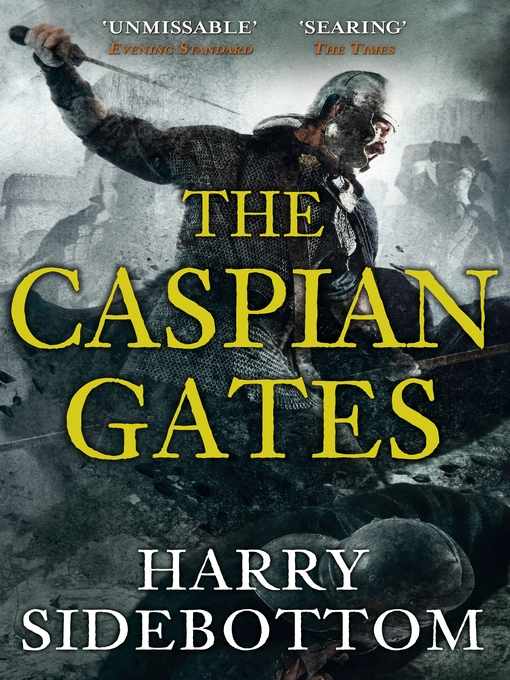The Caspian Gates
by Dr Harry SidebottomIt's 262 AD. The Roman Empire sprawls across Europe and the Mediterranean. Its having a bit of a crisis known as 'the crisis of the third century' - it's suffering from invasions, civil war, plague and economic depression, along with a series of assassinations precipitating hot competition for the throne.

Our hero, Marcus Clodius Ballista or Ballista to his friends lives in Ephesus, a major ancient Greek and later Roman city, roughly located in present-day Turkey. The story opens with he and his familia (his household, including servants) preparing to attend a local day of feasting and sacrifice, to celebrate the anniversary of the accession of a couple of divine Emperors. A snake in the household that very morning is a bad omen. On the way to the feast, Ephesus is crushed by an earthquake and Ballista's home lies in ruins. Ballista manages to get most of his familia to safety, but only by fighting off a boat-load of invading Goths who have taken advantage of the tragedy to do a bit of raping and pillaging.
Ballista isn't your average Roman. In fact, the Romans consider him to be a bit of a barbarian. Ballista isn't even his real name. He started out as Dernhelm, the son of a war-leader of the Angles (who were located roughly where Denmark is now), who trained as a warrior until he was taken as a diplomatic hostage by Romans when he was just 16. He's 30 now, and lives amongst Romans as a peer. He has served in the Roman army, turning out to be a rather successful battle leader and even killing a pretender to the throne and as a result is temporarily declared Emperor, just before this novel starts.
This temporary Emperor business puts the current Emperor, Gallienus, in a bit of a quandary. Gallienus must be seen to discipline Ballista in order to retain his authority, but they were both held as diplomatic hostages as teenagers and became friends. Rather than mete out the death penalty, as might be considered appropriate, Gallienus instead opts to banish Ballista and tie it in with keeping the Empire safe from invaders.
As the story progresses we are treated to battle scene after battle scene, painstakingly rendered in Technicolor historical detail, as Ballista and his familia attempt to move to safety and then (some of them) to exile, to repair the Caspian Gates. For those of us that haven't read the preceding three novels in this 'Warrior of Rome' series (including Fire in the East, King of Kings and Lion of the Sun), we get to know Ballista and his retinue's back story a little better. It turns out that the Goths might not just be motivated by greed, but also by vengeance, and they're not alone
When an author puts their title on the front of the book, you know you're in for an educational experience. It's no surprise that Dr Harry Sidebottom is a proper scholar of this sort of stuff. His research interests exactly overlap with the themes in this story Greek culture under the Roman Empire, and how the Greeks and Romans did warfare which means that this bit of fiction is also a very well-researched and precisely written affair. You get a real feel for the places, the peoples and the culture at the time. The mash-up of different cultures is also very interesting, and portrayed with skill. Whilst it's hardly a reference book, it's still stealthily and subtly educational. It's the complete antithesis to trashy dramas like Rome and Spartacus: Blood and Sand; that's not to say that The Caspian Gates is entirely lacking in the gratuitous sex and gory violence department, but it doesn't dominate the story.
Sidebottom's scholarship and attention to detail also shines through in the collection of appendices he feels the need to include, comprising a historical afterword, a glossary, a list of Roman Emperors and a comprehensive character list indicating their relation to each other and the story.
The historical afterword emphasises the elements of truth in this fictional account. There are quite a lot of these, including some of the characters, events and of course some of the peoples (such as the bloodthirsty Goths). Whilst it might be easy to infer from this that Sidebottom's use of so much truth to structure his story indicates a relative lack of imagination, he has in fact skilfully blended truth with fiction in a way that works surprisingly well.
The existence of the glossary makes sense of all the seemingly nonsensical terms in italics peppered throughout the text. They start off being a bit of a visual irritant, jolting the flow, but eventually blend in to the background: discovering that they're all in an appendix was a surprise, and happily knowing what these terms mean as you're reading isn't essential to the story. However, using the glossary perhaps during a second reading might well enrich the reader experience.
You don't need to have read the preceding three books in this series to appreciate this one, and in fact, reading this one might well encourage you to catch up on the back story. The only downside is that the narrative is sort of left hanging at the end there isn't a sense of closure when you come to the last page. Of course, this is because Sidebottom is leaving our appetites whetted for the next instalment in the series. Another negative is that some of the characters seem a bit superfluous to the story, but again this reflects this book's position in the series: these are characters that readers of previous instalments will have already got to know.
All in all, this tale of treachery and togas is a terrific read even if you're not a Roman-o-phile or that into history. All hail Sidebottom!
